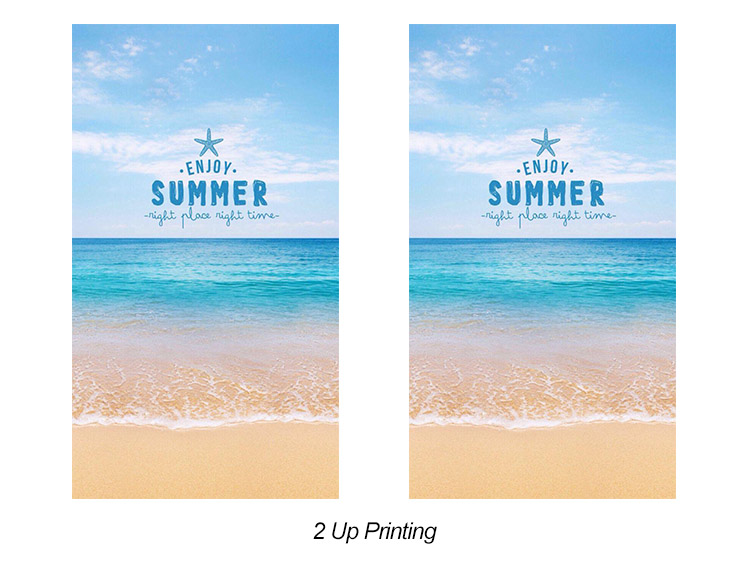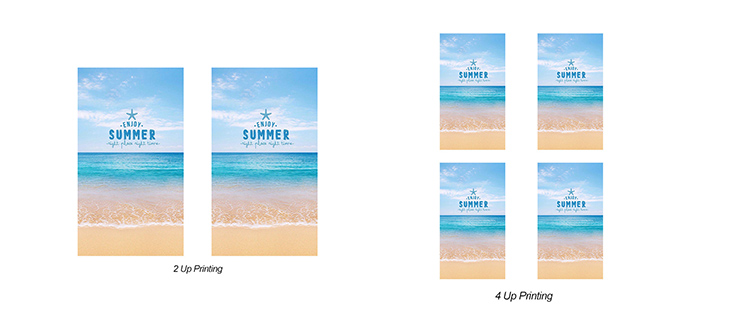The choice between 2 up printing and 4 up printing can significantly impact the efficiency and outcome of your printing projects. As someone deeply entrenched in the printing industry, I've navigated the nuances of these methods to optimize resources and meet client expectations.
This article will explore the distinctions between 2 up and 4 up printing, their advantages, common uses, and tips for successful implementation. I'll also guide you on selecting the right method for your needs and finding a reliable printing service.
What does 2-up Printing Mean?

2-up printing, a term that might seem cryptic to the uninitiated, is actually a straightforward concept in the world of printing. This method involves printing two pages of a document on a single sheet of paper, one beside the other.
2 up printing is not just about saving paper; it's a strategic method to enhance printing efficiency, reduce costs, and minimize waste. When we print documents 2-up, we effectively double our output per sheet, a boon for both high-volume projects and the environmentally conscious.
The process requires careful layout planning to ensure that when the sheet is eventually cut to size, each page is correctly oriented. This necessitates a keen understanding of the printing process, from initial design to the final cut, to avoid common pitfalls such as improper alignment or page sequencing.
The beauty of 2-up printing lies in its simplicity and the tangible benefits it offers, making it a popular choice for various printing projects.
Engaging with 2-up printing has taught me the importance of precision. Every decision, from selecting the appropriate paper size to the final cut, influences the outcome. It's a method that champions efficiency and sustainability, principles that are increasingly important in our industry.
What does 4-up Printing Mean?

Elevating the concept of efficiency in printing, 4-up printing takes the strategy a step further. This method prints four pages on a single sheet of paper, with two pages on each side. This quadruples the output per sheet compared to standard single-page printing, embodying the epitome of efficiency and resourcefulness in the printing process.
The transition from 2-up to 4-up printing is more than just an increase in page count; it's a leap in complexity and potential. The layout, orientation, and sequencing of pages require meticulous attention to detail to ensure that, upon cutting and possibly folding, each mini-page is positioned correctly.
It's a testament to the printer's skill and the intricacies of the printing process, pushing the boundaries of what's achievable with thoughtful design and planning.
Adopting 4-up printing has underscored the importance of innovation and adaptability in our field. It's a method that demands precision and forethought, qualities that are indispensable in the fast-paced world of printing.
The efficiency gains and the reduction in material waste make 4-up printing not only a smart choice for large-scale projects but also a nod towards environmental responsibility.
What does N up Printing Mean?
N up printing serves as the umbrella term encompassing both 2-up and 4-up printing methods, along with any other scenario where multiple pages are printed on a single sheet of paper.
The 'N' in n up printing is a variable, representing any number of pages that can be efficiently arranged on a single sheet. This concept is the backbone of efficient printing, allowing for customizable solutions tailored to the specific needs of each project.
Understanding n up printing is crucial for anyone in the printing industry, as it opens the door to a spectrum of possibilities. It's a principle that champions flexibility, efficiency, and customization, enabling printers to devise strategies that best suit the project at hand.
Whether it's a small-scale job that benefits from 2-up printing or a large order that necessitates the use of 4-up printing or beyond, n up printing provides the framework for making informed decisions.
N up printing is a testament to the ingenuity inherent in our industry, a reminder that innovation is key to meeting the challenges of today's printing demands.
Advantages of 2 Up Printing
One of the primary advantages of 2 up printing is its simplicity. For projects that do not require the high-volume output of 4 up printing, 2 up printing offers a straightforward, efficient alternative. This simplicity extends to the layout and cutting processes, which are less complex and more forgiving of minor errors than their 4 up counterparts.
Another advantage is the flexibility 2 up printing affords. It is well-suited to a variety of projects, from business cards to flyers, without necessitating the rigorous planning and precision required for 4 up printing. This makes it an accessible option for smaller businesses or those just venturing into professional printing.
Furthermore, 2 up printing strikes a balance between efficiency and manageability. It allows for a significant reduction in paper waste and costs without the added complexity of managing four pages on a single sheet. This balance makes 2 up printing a versatile, eco-friendly choice for many printing needs.
Advantages of 4 Up Printing
4 up printing, on the other hand, stands out for its unparalleled efficiency. By maximizing the number of pages per sheet, it drastically reduces paper waste and printing costs, making it an ideal choice for large-scale projects. This efficiency is a cornerstone of sustainable printing practices, aligning with the growing industry focus on environmental responsibility.
The precision and innovation required for successful 4 up printing also foster a high level of professionalism and skill. Printers who master this technique can offer superior quality and efficiency, distinguishing themselves in a competitive market. This expertise is particularly valuable for complex projects that demand meticulous attention to detail.
Additionally, 4 up printing's scalability makes it a versatile option for a wide range of projects. From books and manuals to large promotional materials, it accommodates high-volume printing needs with ease, offering clients cost-effective, high-quality solutions.
Differences between 2 Up Printing and 4 Up Printing

While both 2 up and 4 up printing are predicated on the principle of maximizing efficiency through multi-page layouts, several key differences distinguish these methods.
The most obvious difference is the number of pages per sheet: 2 up printing accommodates two pages, while 4 up printing doubles this capacity. This difference has a ripple effect on various aspects of the printing process, from layout complexity to cutting precision.
The complexity of layout and orientation is significantly heightened in 4 up printing. With four pages to accommodate, the margin for error is slimmer, demanding greater precision in planning and execution. This complexity extends to the cutting and folding stages, where accurate alignment is crucial for the final product's integrity.
Moreover, the choice between 2 up and 4 up printing often hinges on the project's scale and the intended use of the printed materials. Smaller projects or those requiring less frequent handling may be well-suited to 2 up printing. Larger volumes or materials intended for more rigorous use might benefit from the efficiency of 4 up printing. This decision impacts not only the printing process but also the project's overall cost-effectiveness and environmental footprint.
Common Uses for 2 Up Printing
2 up printing is commonly employed for a variety of projects that benefit from its simplicity and efficiency.
usiness cards are a prime example, as they can be printed in large quantities with minimal waste, making 2 up printing a cost-effective solution.
Similarly, flyers and postcards, often used for promotional purposes, are well-suited to 2 up printing due to their standard sizes and the need for high-quality, efficient production.
Brochures and small catalogue printing also benefit from 2 up printing. Their typically moderate page counts and the importance of visual appeal make 2 up printing an ideal balance between efficiency and quality. This method allows for the production of visually appealing, professional-grade materials without the excessive waste and expense associated with traditional single-page printing.
In educational settings, 2 up printing is frequently used for handouts and study materials. The ability to produce double the amount of material on a single sheet not only conserves resources but also simplifies distribution and reduces costs for educational institutions. This practical application underscores the versatility and utility of 2 up printing across various sectors.
Common Uses for 4 Up Printing
4 up printing finds its niche in projects that demand high efficiency and volume. Books and manuals, with their extensive page counts, are ideally suited to 4 up printing. This method allows for the production of large quantities of material in a cost-effective, environmentally friendly manner, making it a preferred choice for publishers and educational institutions.
Promotional materials, particularly those requiring large-scale distribution, also benefit from 4 up printing. Posters, leaflets, and large flyers produced through this method can reach a wide audience with minimal waste, aligning with the goals of sustainable marketing.
Additionally, 4 up printing is valuable for professional documents and reports that require high-volume printing. Corporate entities often utilize this method to efficiently produce annual reports, policy manuals, and other critical documents. The efficiency and quality of 4 up printing ensure that these materials reflect the professionalism and integrity of the organization.
Choosing between 2 Up Printing and 4 Up Printing
The choice between 2 up and 4 up printing hinges on several factors, including project size, complexity, and budget.
For small to medium-sized projects that prioritize simplicity and cost-effectiveness, 2 up printing is often the ideal choice. Its straightforward nature and flexibility make it suitable for a wide range of applications without the need for extensive planning or investment.
For larger, more complex projects that demand high efficiency and volume, 4 up printing is the superior option. Its capacity to significantly reduce costs and environmental impact makes it an attractive choice for large-scale printing needs. The decision between these methods should also consider the available printing technology and expertise, as 4 up printing requires a higher level of precision and skill.
Ultimately, the choice between 2 up and 4 up printing should be informed by a thorough assessment of the project's requirements and goals. Consulting with a professional printing service, such as Chinaprinting4u, can provide valuable insights and guidance, ensuring that the selected method aligns with the project's needs and expectations.
Tips for Successful 2 Up Printing and 4 Up Printing
Achieving success with 2 up and 4 up printing requires careful planning, precision, and attention to detail. For both methods, it's crucial to start with a clear understanding of the layout and design requirements, ensuring that the final product will meet the desired specifications. Utilizing professional design software and consulting with experienced printers can help avoid common pitfalls and enhance the quality of the output.
For 2 up printing, maintaining consistency in page size and layout is essential for a smooth cutting process. Similarly, for 4 up printing, precise alignment and sequencing are critical to ensure that each page is correctly positioned and oriented. Regular communication with the printing service provider can help address any issues promptly and avoid costly mistakes.
Testing and quality control are also vital components of successful 2 up and 4 up printing. Conducting trial runs and reviewing samples can identify potential problems before the full run, saving time and resources. By adhering to these tips and maintaining a focus on quality and efficiency, both 2 up and 4 up printing can produce excellent results that meet or exceed expectations.
In conclusion, the choice between 2 up and 4 up printing depends on a variety of factors, including the project's scale, complexity, and intended use. Each method offers distinct advantages and is suited to different types of printing needs.
After understanding these differences and carefully considering your project's requirements. You can make an informed decision that maximizes efficiency, quality, and cost-effectiveness. Whether you opt for 2 up or 4 up printing, partnering with a reliable printing service can ensure your project's success, leveraging their expertise to produce exceptional results that meet your expectations and beyond.
Finding a Reliable Printing Service for 2 Up and 4 Up Printing
Selecting the right printing service is a critical step in ensuring the success of your 2 up or 4 up printing project. A reliable provider, such as Chinaprinting4u, offers a combination of expertise, technology, and customer service that can make all the difference. When choosing a printing service, consider factors such as the experience with n up printing, the previous work quality and willingness to collaborate closely with clients.
Chinaprinting4u, with proven track record and commitment to excellence, stands out as a premier choice for both 2 up and 4 up printing projects. Our expertise in handling a wide range of printing needs, from small-scale business cards to large-volume books and manuals, ensures that clients receive high-quality, efficient solutions tailored to their specific requirements.


